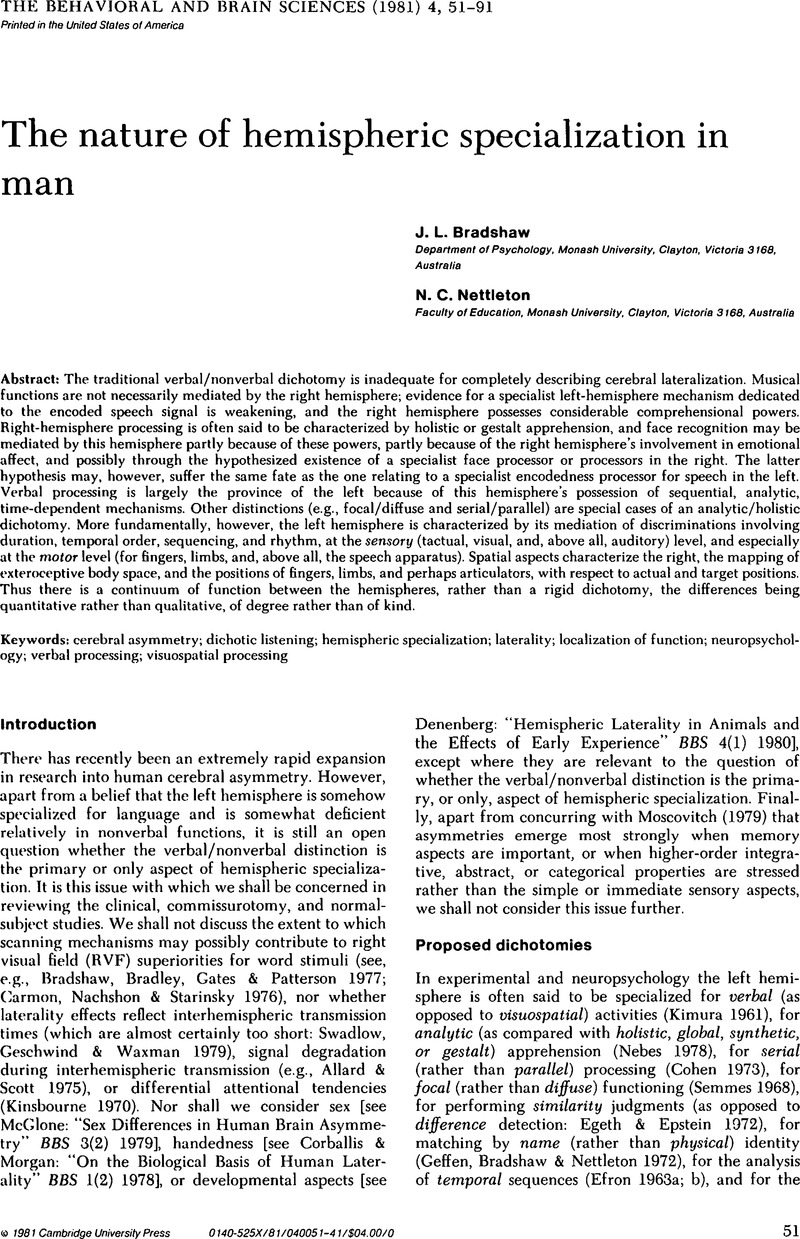Crossref Citations
This article has been cited by the following publications. This list is generated based on data provided by Crossref.
Bertelson, Paul
1982.
Lateral Differences in Normal Man and Lateralization of Brain Function.
International Journal of Psychology,
Vol. 17,
Issue. 1-4,
p.
173.
Sergent, Justine
1983.
The analytic/holistic dichotomy: An epiphenomenon.
Behavioral and Brain Sciences,
Vol. 6,
Issue. 3,
p.
521.
Bogen, J. E.
and
Bogen, G. M.
1983.
Hemispheric specialization and cerebral duality.
Behavioral and Brain Sciences,
Vol. 6,
Issue. 3,
p.
517.
Zaidel, Eran
1983.
Advances and retreats In laterality research.
Behavioral and Brain Sciences,
Vol. 6,
Issue. 3,
p.
523.
Moscovitch, Morris
1983.
Local versus global solutions to problems of hemispheric specialization.
Behavioral and Brain Sciences,
Vol. 6,
Issue. 3,
p.
520.
Bradshaw, John L.
and
Nettleton, Norman C.
1983.
Hemispheric specialization: Return to a house divided.
Behavioral and Brain Sciences,
Vol. 6,
Issue. 3,
p.
528.
Peretz, Isabelle
and
Morais, Jose
1983.
Task determinants of ear differences in melody processing.
Brain and Cognition,
Vol. 2,
Issue. 4,
p.
313.
Jonsson, Jon E.
and
Hellige, Joseph B.
1986.
Lateralized effects of blurring: A test of the visual spatial frequency model of cerebral hemisphere asymmetry.
Neuropsychologia,
Vol. 24,
Issue. 3,
p.
351.
Michimata, Chikashi
1997.
Hemispheric Processing of Categorical and Coordinate Spatial Relations in Vision and Visual Imagery.
Brain and Cognition,
Vol. 33,
Issue. 3,
p.
370.
Beaumont, J. Graham
1997.
Future Research Directions in Laterality.
Neuropsychology Review,
Vol. 7,
Issue. 3,
p.
107.
Hugdahl, Kenneth
2000.
Lateralization of cognitive processes in the brain.
Acta Psychologica,
Vol. 105,
Issue. 2-3,
p.
211.
Dien, Joseph
2008.
Looking both ways through time: The Janus model of lateralized cognition.
Brain and Cognition,
Vol. 67,
Issue. 3,
p.
292.
Porcheddu, Daniele
Usai, Antonio
and
Venturi, Alberto
2011.
Nonverbal stimuli in a virtual aisle: does the shelf you choose matter?.
The International Review of Retail, Distribution and Consumer Research,
Vol. 21,
Issue. 3,
p.
215.


